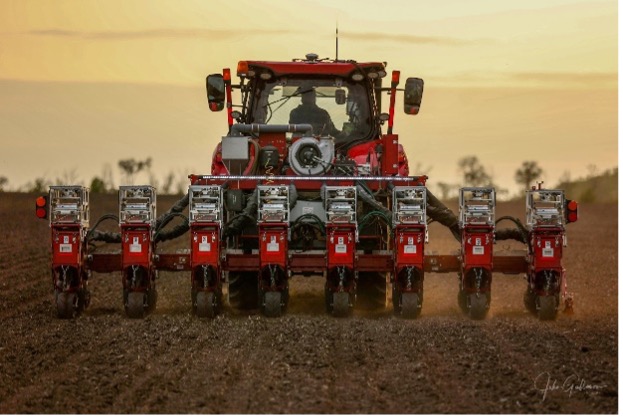Now that we are past June and into July, most of the fields have been planted for the 2024 harvest season. It has been a pretty trying spring for most of the state. The variability in conditions and environments has made for a difficult path forward and in many cases trying to choose the lesser of two evils when it comes to decisions. As this crop develops and the planting season is fresh in our minds, it is time to assess where we did well and where we could improve. In this blog, I’ll explain how our company plants and assess our plots as the season progresses.
We plant millions of plots within Bayer’s North America Breeding organization within our five row crops. How do we plant that many you ask?
Planter photo provided by John Gulleson.
We use custom built planters that are designed to plant “plots”. Now many of you think of a plot as strips of hybrids or varieties in a field and that is correct. In breeding, our plots are small. Usually, two or four 30” rows and anywhere from 35 feet to as little as five feet. We use custom built planters that are designed to be able to switch products on the fly and plant continuously through the field. The seed is packaged at our seed centers and shipped to the growing sites. The testing teams have each field mapped in our custom designed breeding software and a planting prescription uploaded to the planter for it to execute. The planter can capture all the data a grower does and then some. We have all of this data flowing into our systems and we can watch teams plant remotely. Once planting has completed, it is a quick turn around to start assessing location and plot quality.
Within our breeding organization, we plant and grow our research plots in the same fields you grow your crops in. We are faced with many of the same challenges and decisions that farmers face. We also take time to do retrospective looks at our operations and try to better ourselves for the next season. In many ways, assessing breeding plots is very similar in how a farmer would assess their own fields. Breeding plots do have other considerations that a farmer likely does not. Within breeding, we really can’t replant a field. We get one shot to get it right. That means we try not to push too hard too early. We also recognize we need to be timely to subject our next class of products to the same set of environmental conditions a grower will have. We also like to be in-step as best we can with growers to keep field operations in sync.
However, not all our plots go to yield and thus we may operationalize those trials differently. Regardless of what the plots are used for, they need to be of the highest quality for our data to be meaningful. We deactivate or discard a lot of our plots shortly after they emerge. Many people ask – how is that accomplished?
A drone we used in our plots. On the left is a picture of a good plot, and on the right is a picture of a bad plot, both consisting of two rows each.
In basic terms, we assess our fields in the same ways our growers do. But we also need to assess each plot independently, which can be a bit daunting. Our seed will originate from different sources of production as well as having genetic differences. There are multiple variables at play that can impact plot quality. Planter performance or mechanical issues also happen, and we need to identify those issues and remove those plots from the experiments.
Recently, we evaluated our site’s quality by conducting scouting trips through the field and cutting plots that didn’t meet our standards. While dividing the team and quickly walking through several fields seemed efficient, what I considered a poor plot might have been viewed differently by my colleague. As technology has advanced, a solution was found in a way to capture all the fields with “one eye.”
Drones were the solution and have been widely adopted with agriculture to assess fields. We now fly essentially all our trials that go for yield. We can capture pictures of every plot and analyze it with our custom-built imagery analytics to make decisions. The flying is the easier part; however, the harder part is taking the imagery in and getting it processed, stitched analyzed, and data returned in a timely manner. Walking plots is still an important supplement to this data because it allows us to understand the reason why a field is good or poor, but the quality of the data returned is well worth the investment.
We still need to put people in the fields but combining them with our drone fleet has made tremendous differences in out how we operate in our breeding organization. Continue to walk your own fields, but also learn how to apply new techniques and technology to improve your decision making.






 and then
and then